The demand for flexible and reconfigurable landscaping solutions grows in today’s rapidly changing urban environments. As a result, modular green spaces offer an innovative approach to creating adaptable and sustainable outdoor areas that meet various needs. This blog explores the concept of modular green spaces, their benefits, examples from British Columbia, and future trends.
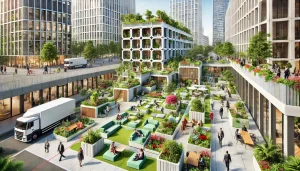
Definition of Modular Green Spaces
Modular green spaces use interchangeable and movable components for landscaping. Consequently, these components allow for rearrangement or expansion, which supports dynamic and flexible outdoor spaces. This approach fits urban environments where space is limited and needs change over time.
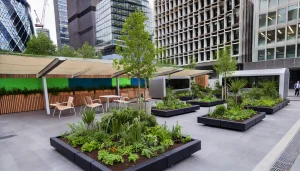
Benefits of Modular Green Spaces
Firstly, flexibility and adaptability: Modular green spaces allow for easy reconfiguration to suit different needs, such as expanding seating areas, adding new plant species, or creating play zones for children. Secondly, sustainability: Modular components reduce waste and promote material reuse, contributing to a more sustainable environment. Moreover, cost-effectiveness: Modular solutions often prove cost-effective over time, allowing gradual expansion and adaptation without requiring complete overhauls. Additionally, accessibility: Modular green spaces can accommodate people of all ages and abilities, promoting inclusivity and community engagement.
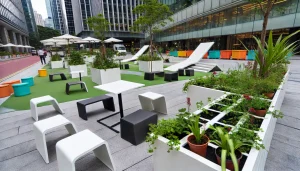
Examples of Modular Green Spaces in British Columbia
For instance, the Polygon Gallery in North Vancouver exemplifies a modular green space. The gallery’s exterior features movable planters and seating that can be rearranged for various events and community activities. This flexibility lets the space serve as a venue for art installations, markets, and social gatherings.
Similarly, the SFU Sustainable Energy Engineering Building in Surrey incorporates modular green roofs and terraces. The design includes modular planters and seating areas that can be reconfigured for educational activities, social events, and quiet study sessions, making the most of available space.
Additionally, the Vancouver Convention Centre boasts one of North America’s largest modular green roofs. The roof features a variety of plant species in modular trays that can be replaced or reconfigured as needed. This design enhances biodiversity and allows for easy maintenance and adaptability to changing environmental conditions.
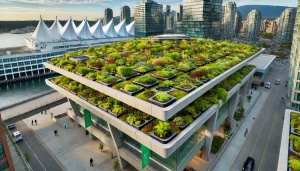
Innovative Materials and Technologies
Modular green spaces often use innovative materials and technologies to enhance their functionality and sustainability. Some include:
- Recycled materials: Using recycled plastic, rubber, and other materials for planters, seating, and paving helps reduce environmental impact.
- Smart irrigation systems: These systems deliver water to each plant, reduce waste, and optimize water use.
- Lightweight soil media: Specialized soil mixtures reduce the weight of green roofs and planters, making them easier to move and reconfigure.
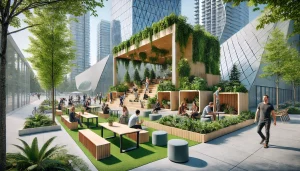
Steps for Planning and Implementing Modular Green Spaces
- Assessment and planning: Evaluate the available space and determine the needs and goals of the green space. Consider factors such as sun exposure, water availability, and intended use.
- Design: Create a modular design with interchangeable components such as planters, seating, and walkways. Ensure the design is flexible and easily adaptable.
- Material selection: Choose sustainable and lightweight materials that are easy to move and reconfigure. Consider using recycled materials and incorporating smart technologies.
- Installation: Assemble the modular components according to the design. Ensure proper installation of irrigation systems and other technologies.
- Maintenance: Regularly maintain the modular green space by monitoring plant health, adjusting configurations as needed, and ensuring the functionality of smart systems.
Future Trends and Potential Developments
The future of modular green spaces promises ongoing innovations and developments. Some potential trends include:
- Increased use of technology: Advances in smart technologies, such as automated irrigation and monitoring systems, will enhance the efficiency and sustainability of modular green spaces.
- Integration with urban infrastructure: Modular green spaces, such as rooftops, walls, and public transportation hubs, will increasingly integrate into urban infrastructure.
- Community involvement: Emphasizing community involvement in planning and maintaining modular green spaces will foster a sense of ownership and engagement.
Overall, modular green spaces offer a flexible, sustainable, and cost-effective solution for creating dynamic and adaptable outdoor environments. With examples from British Columbia showcasing their potential, these innovative landscaping solutions are set to become a key component of urban planning and development. By embracing modular green spaces, gardeners and landscapers can create versatile and resilient spaces that meet the evolving needs of our communities.